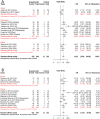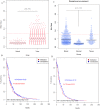A Systematic Analysis of the Relationship of CDH13 Promoter Methylation and Breast Cancer Risk and Prognosis
- PMID: 27153114
- PMCID: PMC4859545
- DOI: 10.1371/journal.pone.0149185
A Systematic Analysis of the Relationship of CDH13 Promoter Methylation and Breast Cancer Risk and Prognosis
Abstract
Background: CDH13 (cadherin 13) is a special cadherin cell adhesion molecule, and the methylation of its promoter causes inactivation in a considerable number of human cancers. To explore the association between CDH13 promoter methylation and breast cancer risk and prognosis, we systematically integrated published articles to investigate the diagnostic performance of the CDH13 methylation test for breast cancer. An independent DNA methylation microarray dataset from The Cancer Genome Atlas project (TCGA) project was used to validate the results of the meta-analysis.
Methods: The relevant literature was searched using the PubMed, Cochrane Library, Web of Science and Google Scholar databases for articles published in English up to May 2015. Data were analyzed using random effect or fixed effect models. The effect sizes were estimated by measuring an odds ratio (OR) or hazard ratio (HR) with a 95% confidence interval (CI). A chi-squared based Q test and sensitivity analysis were performed to examine the between-study heterogeneity and the contribution of single studies to the final results, respectively. Funnel plots were constructed to evaluate publication bias.
Results: Seven hundred and twenty-six breast tumor samples and 422 controls were collected from 13 published studies. The data from the TCGA set include both tumor and normal samples. A significant association was observed between CDH13 promoter methylation and breast cancer, with an aggregated OR equal to 13.73 (95%CI: 8.09~23.31, z = 9.70, p<0.0001) as measured using the fixed effect model and 14.23 (95%CI: 5.06~40.05, z = 5.03, p<0.0001) as measured using a random effect model. The HR values were calculated as 0.77 (95%CI: 0.27~2.21, z = -0.49, p = 0.622) and 0.38 (95%CI: 0.09~1.69, z = -1.27, p = 0.20) for overall survival (OS) and disease-free survival (DFS), respectively, using the random effect model. This result indicated that breast cancer patients with CDH13 promoter methylation correlated non-significantly with prognosis and is therefore similar to the findings of the TCGA project.
Conclusions: The methylation status of CDH13 promoter was strongly associated with breast cancer risk. However, CDH13 promoter methylation was not significantly related to the OS and DFS of breast cancer and may have limited prognostic value for breast cancer patients.
Conflict of interest statement
Figures






Similar articles
-
The relationship between RASSF1A gene promoter methylation and the susceptibility and prognosis of melanoma: A meta-analysis and bioinformatics.PLoS One. 2017 Feb 16;12(2):e0171676. doi: 10.1371/journal.pone.0171676. eCollection 2017. PLoS One. 2017. PMID: 28207831 Free PMC article.
-
Clinical and prognostic effects of CDKN2A, CDKN2B and CDH13 promoter methylation in ovarian cancer: a study using meta-analysis and TCGA data.Biomarkers. 2019 Nov;24(7):700-711. doi: 10.1080/1354750X.2019.1652685. Epub 2019 Sep 5. Biomarkers. 2019. PMID: 31382782
-
Aberrant Methylation of T-cadherin Can Be a Diagnostic Biomarker for Colorectal Cancer.Cancer Genomics Proteomics. 2017 Jul-Aug;14(4):277-284. doi: 10.21873/cgp.20038. Cancer Genomics Proteomics. 2017. PMID: 28647701 Free PMC article.
-
Association of BRCA1 Promoter Methylation with Breast Cancer in Asia: A Meta- Analysis.Asian Pac J Cancer Prev. 2018 Apr 25;19(4):885-889. doi: 10.22034/APJCP.2018.19.4.885. Asian Pac J Cancer Prev. 2018. PMID: 29693332 Free PMC article.
-
Aberrant methylation of H-cadherin (CDH13) promoter is associated with tumor progression in primary nonsmall cell lung carcinoma.Cancer. 2005 Nov 1;104(9):1825-33. doi: 10.1002/cncr.21409. Cancer. 2005. PMID: 16177988 Review.
Cited by
-
Potential role of TWIST1 and its methylation in bladder urothelial carcinoma.Transl Cancer Res. 2024 Nov 30;13(11):6070-6086. doi: 10.21037/tcr-24-1029. Epub 2024 Nov 21. Transl Cancer Res. 2024. PMID: 39697731 Free PMC article.
-
Genome-wide differential DNA methylation analysis of MDA-MB-231 breast cancer cells treated with curcumin derivatives, ST08 and ST09.BMC Genomics. 2022 Dec 6;23(1):807. doi: 10.1186/s12864-022-09041-2. BMC Genomics. 2022. PMID: 36474139 Free PMC article.
-
Expression Profile and Prognostic Values of CDH Family Members in Lung Adenocarcinoma.Dis Markers. 2022 Feb 11;2022:9644466. doi: 10.1155/2022/9644466. eCollection 2022. Dis Markers. 2022. Retraction in: Dis Markers. 2023 Oct 4;2023:9896249. doi: 10.1155/2023/9896249. PMID: 35242247 Free PMC article. Retracted.
-
ST08 Altered NF-κB Pathway in Breast Cancer Cells In Vitro as Revealed by miRNA-mRNA Analysis and Enhanced the Effect of Cisplatin on Tumour Reduction in EAC Mouse Model.Front Oncol. 2022 May 9;12:835027. doi: 10.3389/fonc.2022.835027. eCollection 2022. Front Oncol. 2022. PMID: 35615145 Free PMC article.
-
Effect of adiponectin level and genetic variation of its receptors on diabetic retinopathy: A case-control study.Medicine (Baltimore). 2019 Mar;98(11):e14878. doi: 10.1097/MD.0000000000014878. Medicine (Baltimore). 2019. PMID: 30882695 Free PMC article.
References
-
- Bernard W, Stewart CPW. World Cancer Report 2014. World Health Organization. 2014.
-
- Takeuchi T, Ohtsuki Y. Recent progress in T-cadherin (CDH13, H-cadherin) research. Histol Histopathol. 2001;16(4):1287–93. . - PubMed
Publication types
MeSH terms
Substances
LinkOut - more resources
Full Text Sources
Other Literature Sources
Medical
Miscellaneous

